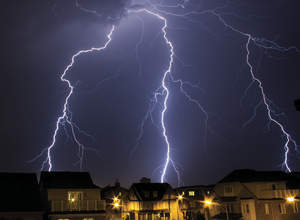MISSION, KS--(Marketwired - Aug 17, 2016) - (Family Features) When a major storm strikes, it can leave a trail of devastation and danger behind. Volatile weather is common when seasons change, so it's the perfect time to take stock of your emergency resources.
Power outages are common once a hurricane or tornado has stricken and can create additional danger to families. Without power, you lose easy access to important news and weather updates on the radio or TV. In addition, sustained power outages can cause a food supply shortage due to loss of refrigeration, and you can expect to be without lights at night or hot water for showers and cleaning.
In the aftermath of a major storm, it can take weeks or even months to fully restore power. When disaster strikes, backup power is extremely important to make a difficult situation more bearable and even save lives.
When used properly, portable generators can provide an excellent backup power source to help keep your family safe when you encounter severe weather and natural disasters. When used incorrectly, however, generators can pose a serious risk of carbon monoxide poisoning. Emitted in toxic engine exhaust, carbon monoxide is tasteless, colorless, odorless and potentially deadly.
The Portable Generator Manufacturers' Association recommends taking time to reacquaint yourself with your generator's features and safe operating instructions, as well as keeping these safety tips in mind:
- Keep the operator's manual in a safe place so you can refer to it easily for further information about safe operation and potential hazards.
- To avoid dangerous carbon monoxide accumulation from a portable generator, always "Take It Outside." Never run a portable generator indoors, in areas such as garages, basements, crawl spaces, breezeways, sheds or other partially enclosed spaces.
- Always place a portable generator downwind and point the engine exhaust away from occupied spaces.
- Avoid placing a portable generator near windows, doors or vents, as carbon monoxide gas can accumulate and potentially be drawn indoors.
- Install battery-operated carbon monoxide alarms according to manufacturer's instructions. Replace batteries and test the alarm regularly to ensure it is in good working condition.
- Learn to recognize the symptoms of carbon monoxide poisoning: headache, nausea, dizziness, shortness of breath, weakness and fainting.
- If you feel sick, dizzy or weak while using your portable generator, get to fresh air immediately and call 911 for emergency medical attention.
Now is the perfect time to educate yourself and your family on the safe and proper use of portable generators in preparation for major storms and natural disasters.
Learn more about safely operating a portable generator during severe weather at pgmaonline.com and takeyourgeneratoroutside.com.
About Family Features Editorial Syndicate
Established in 1974, Family Features is a leading provider of free food and lifestyle content for print and online publications. Our articles, photos, videos and web content solutions save you time, money and help create advertising opportunities. Registration is fast and free -- with absolutely no obligation. Visit editors.familyfeatures.com for more information.
Contact Information:
Michael French
mfrench@familyfeatures.com
1-888-824-3337
editors.familyfeatures.com
